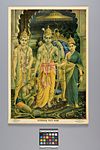Ayohia Pati Ram
About this object
History of use
Indian popular religious prints have been published for nearly a century, first by German presses, later by Indian ones. The prints may take the form of calendars, posters, or simply images. The style of the representations is European. In the beginning they were Hindu images, but are now acquiring elements both of folk art and a romantic secularism. It is a living art currently influenced by the movie industry and non-Hindu religions. The images are a vehicle for advertising and are also used for religious purposes. This print was produced, framed, and displayed in a prayer room for 'puja' or worship.
Cultural context
popular religious art
Iconographic meaning
Rama is the seventh incarnation of Vishnu and is identified by the 'u' shape on his forehead, the bow over his shoulder, and the presence of his wife, Sita, and brother, Lakshman. The sun on the throne is their family symbol. When Sita was kidnapped by Ravana, Rama, Lakshman, and Hanuman (also shown and identified by half-man, half-monkey features) fought to free her. When freed, Sita gave her pearl necklace to Hanuman. The golden mace indicates royal power.
Physical description
Rectangular shaped print depicting Hanuman in crouched position, hands held together as if praying. He wears a pearl necklace and has a golden mace at his side. Standing, left to right, Lakshmana holding a bow in his left hand, wearing a green sash, yellow garment and white, yellow and blue necklaces. In the middle is Rama holding a bow in his left hand, his right hand is above Hanuman’s head, wearing a pink sash, yellow garment and white, yellow and blue necklaces. Both men each have white 'u' shape on forehead. Sati is wearing a green and yellow sari, her right hand is raised towards Hanuman, her left hand holds a pink flower. Behind the group is a blue throne which has a gold shade attached to a sun symbol. All stand on a floral carpet. Background: through pillared archways are trees water and sky. In bottom right of image is artist's signature. At base: 'Published by S.S. Brijbasi and Sons. Picture publishers, Mathura âu.p.ê' is printed in left hand corner; centre printed with title; and 'Cpy Regd. No. 2082a. Printed by Brijbasi F.A.O. Works, Mathura, India' printed in right hand corner.
Categories
Materials
